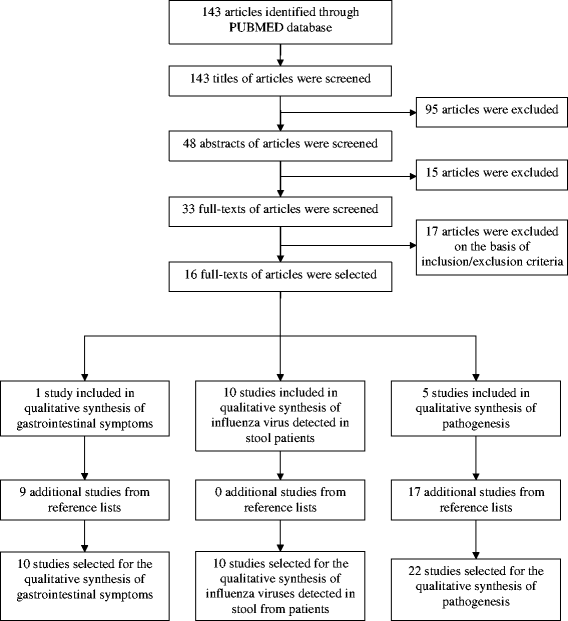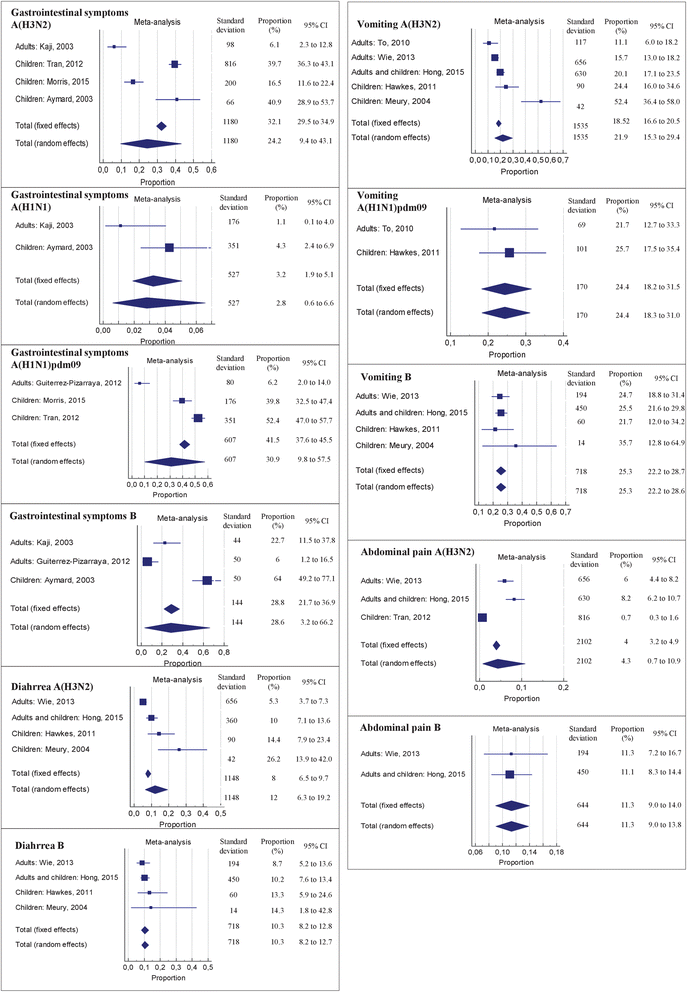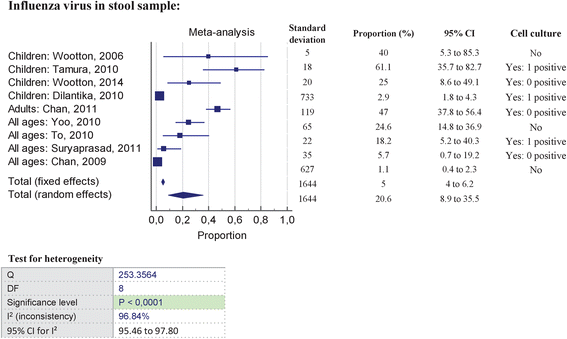Prevalence of gastrointestinal symptoms in patients with influenza, clinical significance, and pathophysiology of human influenza viruses in faecal samples: what do we know?
- PMID: 26651485
- PMCID: PMC4676820
- DOI: 10.1186/s12985-015-0448-4
Prevalence of gastrointestinal symptoms in patients with influenza, clinical significance, and pathophysiology of human influenza viruses in faecal samples: what do we know?
Abstract
This review provides for the first time an assessment of the current understanding about the occurrence and the clinical significance of gastrointestinal (GI) symptoms in influenza patients, and their correlation with the presence of human influenza viruses in stools of patients with confirmed influenza virus infection. Studies exploring how human influenza viruses spread to the patient's GI tract after a primary respiratory infection have been summarized. We conducted a systematic search of published peer-reviewed literature up to June 2015 with regard to the above-mentioned aspects, focusing on human influenza viruses (A(H1N1), A(H1N1)pdm09, A(H3N2), and B). Forty-four studies were included in this systematic review and meta-analysis. The pooled prevalence of any digestive symptoms ranged from 30.9% (95% CI, 9.8 to 57.5; I(2) = 97.5%) for A(H1N1)pdm09 to 2.8% (95% CI, 0.6 to 6.5; I(2) = 75.4%) for A(H1N1). The pooled prevalence of influenza viruses in stool was 20.6% (95% CI, 8.9 to 35.5; I(2) = 96.8%), but their correlation with GI symptoms has rarely been explored. The presence of viral RNA in stools because of haematogenous dissemination to organs via infected lymphocytes is likely, but the potential to cause direct intestinal infection and faecal-oral transmission warrants further investigation. This review highlights the gaps in our knowledge, and the high degree of uncertainty about the prevalence and significance of GI symptoms in patients with influenza and their correlation with viral RNA positivity in stool because of the high level of heterogeneity among studies.
Figures



Comment in
-
Long term detection of seasonal influenza RNA in faeces and intestine - Author's Reply.Clin Microbiol Infect. 2017 Apr;23(4):273-274. doi: 10.1016/j.cmi.2016.09.020. Epub 2016 Sep 29. Clin Microbiol Infect. 2017. PMID: 27693655 No abstract available.
Similar articles
-
Physical interventions to interrupt or reduce the spread of respiratory viruses.Cochrane Database Syst Rev. 2023 Jan 30;1(1):CD006207. doi: 10.1002/14651858.CD006207.pub6. Cochrane Database Syst Rev. 2023. PMID: 36715243 Free PMC article.
-
Neuraminidase inhibitors for preventing and treating influenza in healthy adults and children.Cochrane Database Syst Rev. 2012 Jan 18;1:CD008965. doi: 10.1002/14651858.CD008965.pub3. Cochrane Database Syst Rev. 2012. Update in: Cochrane Database Syst Rev. 2014 Apr 10;(4):CD008965. doi: 10.1002/14651858.CD008965.pub4. PMID: 22258996 Updated.
-
Signs and symptoms to determine if a patient presenting in primary care or hospital outpatient settings has COVID-19.Cochrane Database Syst Rev. 2022 May 20;5(5):CD013665. doi: 10.1002/14651858.CD013665.pub3. Cochrane Database Syst Rev. 2022. PMID: 35593186 Free PMC article.
-
Vaccines for preventing influenza in the elderly.Cochrane Database Syst Rev. 2018 Feb 1;2(2):CD004876. doi: 10.1002/14651858.CD004876.pub4. Cochrane Database Syst Rev. 2018. PMID: 29388197 Free PMC article.
-
Drugs for preventing postoperative nausea and vomiting in adults after general anaesthesia: a network meta-analysis.Cochrane Database Syst Rev. 2020 Oct 19;10(10):CD012859. doi: 10.1002/14651858.CD012859.pub2. Cochrane Database Syst Rev. 2020. PMID: 33075160 Free PMC article.
Cited by
-
Traditional Chinese Medicine Injections Combined With Oseltamivir for Influenza: Systematic Review and Network Meta-Analysis.Front Pharmacol. 2022 Jul 22;13:848770. doi: 10.3389/fphar.2022.848770. eCollection 2022. Front Pharmacol. 2022. PMID: 35935865 Free PMC article.
-
Nonrespiratory sites of influenza-associated disease: mechanisms and experimental systems for continued study.FEBS J. 2022 Jul;289(14):4038-4060. doi: 10.1111/febs.16363. Epub 2022 Feb 7. FEBS J. 2022. PMID: 35060315 Free PMC article. Review.
-
Abdominal imaging in ICU patients with viral pneumonia: Are findings in COVID-19 patients really different from those observed with non-SARS-CoV-2 viral pneumonia?Res Diagn Interv Imaging. 2022 Mar;1:100001. doi: 10.1016/j.redii.2022.01.001. Epub 2022 Feb 7. Res Diagn Interv Imaging. 2022. PMID: 37520012 Free PMC article.
-
Gut-lung axis and asthma: A historical review on mechanism and future perspective.Clin Transl Allergy. 2024 May;14(5):e12356. doi: 10.1002/clt2.12356. Clin Transl Allergy. 2024. PMID: 38687096 Free PMC article. Review.
-
Anti-influenza A virus activity of two Newtonia species and the isolated compound myricetin-3-o-rhamnoside.BMC Complement Med Ther. 2021 Mar 16;21(1):92. doi: 10.1186/s12906-021-03250-0. BMC Complement Med Ther. 2021. PMID: 33726731 Free PMC article.
References
-
- Aymard M, Valette M, Luciani J. Burden of influenza in children: preliminary data from a pilot survey network on community diseases. Pediatr Infect Dis J. 2003;22:S211–S214. doi: 10.1097/01.inf.0000092189.42748.cc. - DOI - PubMed
Publication types
MeSH terms
LinkOut - more resources
Full Text Sources
Other Literature Sources
Medical

